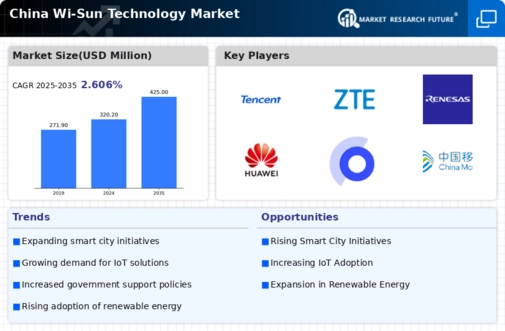Growth of Smart City Projects
The proliferation of smart city projects across China is acting as a catalyst for the wi sun-technology market. As urban areas continue to expand, local governments are increasingly investing in smart infrastructure to enhance urban living conditions. The wi sun-technology market is integral to these projects, providing the necessary communication framework for various applications, including smart lighting, waste management, and traffic monitoring. With an estimated investment of over $100 billion in smart city initiatives by 2025, the demand for reliable and efficient communication technologies is expected to rise. This growth presents a substantial opportunity for companies operating within the wi sun-technology market, as they seek to provide innovative solutions that meet the evolving needs of urban environments. The alignment of wi sun-technology with smart city objectives is likely to drive sustained market growth.
Increased Focus on Energy Efficiency
The growing emphasis on energy efficiency in China is significantly impacting the wi sun-technology market. As energy costs rise and environmental concerns become more pressing, both consumers and businesses are seeking solutions that promote energy conservation. The wi sun-technology market is well-suited to address these needs, offering technologies that enable better energy management and monitoring. Recent studies indicate that implementing wi sun-technology can lead to energy savings of up to 30% in various applications. This focus on energy efficiency is further supported by government policies that incentivize the adoption of smart technologies. As organizations strive to reduce their carbon footprint and operational costs, the demand for wi sun-technology solutions is likely to increase, positioning the market for robust growth in the coming years.
Integration with Internet of Things (IoT)
The integration of wi sun-technology with the Internet of Things (IoT) is emerging as a pivotal driver in the Chinese market. As IoT applications proliferate across various sectors, the demand for reliable and low-power communication technologies is intensifying. The wi sun-technology market is well-positioned to support IoT ecosystems, particularly in smart cities and industrial automation. With an estimated 1.4 billion connected devices expected in China by 2025, the need for efficient data transmission and connectivity solutions is paramount. This integration not only enhances operational efficiencies but also supports the development of innovative applications in sectors such as agriculture, healthcare, and transportation. The synergy between wi sun-technology and IoT is likely to propel market growth, as businesses and municipalities seek to leverage advanced connectivity solutions.
Rising Demand for Smart Metering Solutions
The wi sun-technology market in China is experiencing a notable surge in demand for smart metering solutions. This trend is largely driven by the need for efficient energy management and the integration of renewable energy sources. As urbanization accelerates, the Chinese government is investing heavily in smart grid technologies, which are expected to reach a market value of approximately $30 billion by 2026. The implementation of smart meters allows for real-time monitoring and management of energy consumption, thereby enhancing operational efficiency. Furthermore, the increasing focus on reducing carbon emissions aligns with the deployment of wi sun-technology, which facilitates better energy distribution and consumption patterns. This driver indicates a robust growth trajectory for the wi sun-technology market, as stakeholders seek to capitalize on the benefits of smart metering in urban environments.
Government Initiatives for Sustainable Development
Government initiatives aimed at promoting sustainable development are significantly influencing the wi sun-technology market in China. The Chinese government has set ambitious targets for reducing greenhouse gas emissions and increasing the share of renewable energy in its energy mix. As part of these initiatives, policies are being implemented to encourage the adoption of smart technologies, including wi sun-technology. For instance, the government has allocated substantial funding for research and development in smart grid technologies, with investments projected to exceed $20 billion by 2025. This supportive regulatory environment is fostering innovation and attracting investments in the wi sun-technology market, as companies align their strategies with national sustainability goals. The emphasis on eco-friendly solutions is likely to drive market expansion, as stakeholders recognize the importance of integrating sustainable practices into their operations.

























Leave a Comment